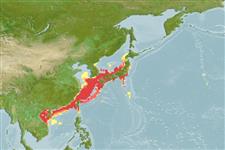Environment: milieu / climate zone / intervalo de profundidade / distribution range
Ecologia
marinhas demersal; intervalo de profundidade 50 - 275 m (Ref. 9824). Temperate
Northwest Pacific: Japan, Formosa Strait, northern part of the South China Sea. Possibly occurring in the Western Central Pacific.
Tamanho / Peso / Idade
Maturidade: Lm ? range ? - ? cm
Max length : 12.0 cm TL macho/indeterminado; (Ref. 9824)
Espinhos dorsais (total) : 0; Raios dorsais moles (total) : 79 - 86; Espinhos anais: 0; Raios anais moles: 59 - 67. Tip of isthmus below middle of lower eye. Scales on ocular side ctenoid, armed with a row of hairlike spines. Caudal fin with 3 simple rays on upper and lower margins respectively. Pectoral fin elongated into a filament, longer than head. Caudal fin without a dark band. In male, body on blind side stained with dark-blue except for head, interorbital width broader and pectoral fin longer than in female.
Body shape (shape guide): short and / or deep; Cross section: compressed.
Lives on sand and shell bottoms and feeds on bottom-living animals. Sexually dimorphic characters develop at about 5 cm SL.
Life cycle and mating behavior
Maturidade | Reprodução | Desova | Ovos | Fecundidade | Larvas
Hensley, D.A. and K. Amaoka, 2001. Bothidae. Lefteye flounders. p. 3799-3841. In K.E. Carpenter and V. Niem (eds.) FAO species identification guide for fishery purposes. The living marine resources of the Western Central Pacific. Vol. 6. Bony fishes part 4 (Labridae to Latimeriidae), estuarine crocodiles. FAO, Rome. (Ref. 9824)
Categoria na Lista Vermelha da IUCN (Ref. 130435: Version 2025-1)
Ameaça para o homem
Harmless
Utilização humana
Pescarias: sem interesse
Ferramentas
Relatórios especiais
Descarregue XML
Fontes da internet
Estimates based on models
Preferred temperature (Ref.
123201): 9.7 - 21.8, mean 18.2 °C (based on 160 cells).
Phylogenetic diversity index (Ref.
82804): PD
50 = 0.5312 [Uniqueness, from 0.5 = low to 2.0 = high].
Bayesian length-weight: a=0.00912 (0.00408 - 0.02036), b=3.04 (2.85 - 3.23), in cm total length, based on LWR estimates for this (Sub)family-body shape (Ref.
93245).
Nível Trófico (Ref.
69278): 3.5 ±0.37 se; based on food items.
Resiliência (Ref.
120179): Médio, tempo mínimo de duplicação da população 1,4 - 4,4 anos (Preliminary K or Fecundity.).
Fishing Vulnerability (Ref.
59153): Low vulnerability (10 of 100).
🛈
